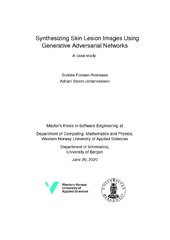| dc.description.abstract | According to the World Health Organization cancer is the second leading cause of death globally [1], and the most common cancer in the world is skin cancer [2]. To get a skin cancer diagnosis, a patient will usually mention their concern to a doctor. The doctor will then refer the patient to a dermatologist, who takes a closer look to determine whether the lesion is abnormal and in need of further inspection. If it’s abnormal, the next step is usually a biopsy of the lesion for further testing in a laboratory. The test results determine the final diagnosis. The dermatologist uses an array of different techniques and tools to examine the lesion, one of which is often a dermoscope. A dermoscope is a handheld device that makes it possible to see structures in the skin that normally are invisible to the naked eye. Nowadays dermoscopes are usually equipped with a camera, allowing the physician to digitally store images of the lesion. This makes it easier to get a second opinion. Either from another physician, or in the interest of this thesis, from some state-of-the-art automated skin cancer detection system, i.e. computer-aided diagnosis (CAD). The idea of having CAD tools act as second opinions has become more plausible than ever, with the recent improvements in machine learning (ML) seen in the last decade. Most importantly, the last years developments within the sub-fields of neural network (NN), deep learning (DL), and computer vision. This have caused plenty of new startups, companies, software, and applications for medical image analysis. In the subject of skin cancer, there has been a great deal of activity around the field of machine learning, ranging from simple mobile applications to comprehensive research into clinical utility. In 2017, Andre Esteva et al. published a paper which showed that machine learning models can perform at the level of dermatologists [3]. In 2018, H. A. Haenssel et al. constructed a convolutional neural network that in most cases outperformed 58 dermatologist. They claimed that any physicians, regardless of experience, may benefit from including a machine learning model in their evaluation [4]. A main reason for the success of neural networks is their ability to automatically extract useful features from data (representation learning). Data can also be said to be the methods greatest weakness: the performance of the model becomes extremely dependent on the quantity and quality of the data its being fed. The problem of acquiring high-quality data is particularly challenging when working with medical data. Because of the highly restrictive privacy protection of sensitive patient data, the resources needed for correctly labeling it, and the highly imbalanced nature of medical data, the process of collecting medical data is both difficult and expensive. In this thesis, we will try to reduce the problem of low amounts of data in machine learning by artificially creating more data using generative models, more specifically Generative Adversarial Network (GAN). We will create synthetic images of skin lesions, expanding the original data set. In addition to generating visually accurate synthetic data, our goal is to improve machine learning models by adding synthetic training data. | en_US |
